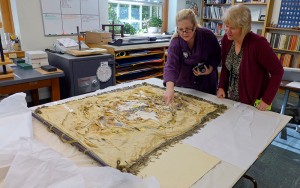This article is more than 5 years old.
While reading the Winston-Salem Journal this past summer, I saw the familiar name of African American artist David Bustill Bowser appearing in a reprinted Atlanta Journal Constitution article. Bowser, born in 1820 (d. 1900) and based in Philadelphia, made his living painting ornamental banners, portraits, and during the Civil War, flags for African American Union regiments. Wake Forest has an important connection with Bowser as he was the artist of our 1857 Philomathesian banner.

The Philomathesian Society was one of two literary groups that began at Wake Forest in 1835 (the Euzelians being the other). For much of the 1800s, these societies challenged young farmers and ministerial students to study and debate historical, political, and philosophical questions of the day. In addition to intellectual stimulation, the societies gave the members a sense of fellowship and belonging. For a century, the societies guided students’ intellectual, moral and social development, and heavily influenced campus life, from governing student behavior to selecting Commencement speakers. The societies met weekly in separate ornate halls decorated with expensive carpets and draperies and portraits of distinguished alumni members. Each society stocked its bookshelves with periodicals and history and reference books. The society libraries merged to form the College library in the 1880s.
The original Philomathesian banner (1832) was burned in a fire, and Bowser’s 1857 banner, currently part of Special Collections & Archives, was given to the College by the Clio Society at the Oxford Female Seminary (a now-defunct sister institution to Wake Forest). The banner is in extremely poor condition, being painted silk. In 2015, ZSR Library funded a visit by conservator Claudia Walpole, based in Charlottesville, Virginia. She unfolded the banner, discovered the artist who had signed his work, and stabilized it as best she could. Ms. Walpole provided an in-depth report detailing what conservation work she had completed and what was still needed for its complete conservation. This same year, the North Carolina Preservation Consortium named the banner an Endangered Artifact and Kerry King completed an in-depth story for Wake Forest Magazine.

The banner is resting safely in its acid-free tissue and box housing but Special Collections & Archives and the ZSR Library are still hoping to find a donor or donors willing to fund the conservation of this key relic of both Wake Forest and American history. For further information, please contact ZSR Library’s Assistant Director for College and Library Development, Mika Payden-Travers.

5 Comments on ‘A Wake Forest Connection with African American History’
What a fascinating past and an endangered future! It is amazing that this silk item is even salvageable. Thanks for letting us know about this fragile piece of WFUs history.
Watching Claudia examine the Philomathesian banner in my lab and hearing her exclaim she’d found the painter’s name on a shard of paint was amazing. That banner has amazing hidden secrets we were able to uncover in that survey. Thanks for writing about this piece of Wake Forest history.
This is so interesting! Thanks for posting, Tanya.
Informative and intriguing. Thanks for sharing.
Thank you for this valuable and informative report that reminds me of a book I once read describing historians also as detectives.